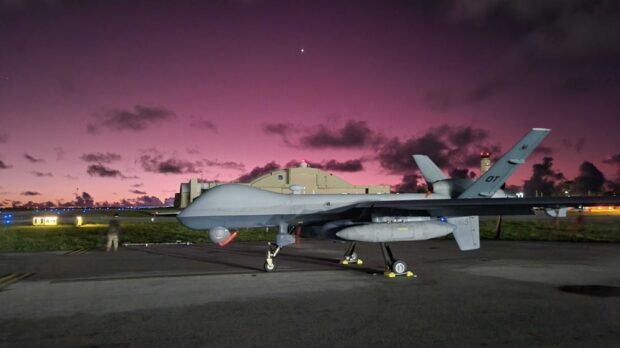Airmen on the South Pacific island of Palau watched intently as an MQ-9 Reaper flew in for an automatic landing recently. None grabbed the controls from the pilot, 7,000 miles away at Creech Air Force Base, Nevada. The landing marked the first time in a major Pacific exercise that the Reaper landed without ground control.
The Reaper’s new automatic takeoff and landing capability (ATLC), made possible with just a pallet and half of equipment, was at work again an hour later, as the the Reaper launched again. The Reaper agile combat employment, or RACE, demonstration was part of June’s Valiant Shield exercise.
“It’s fundamentally shaking up how we present our force, because I don’t need everybody downrange anymore,”
Lt. Col. Michael Chmielewski, commander of the 556th Test and Evaluation Squadron at Creech, which oversaw the MQ-9s, told Air Force Magazine. Only 10 Airmen made the trip, instead of 55.
“What we started doing was just full control over satellites,” he explained. “It turns out, you can do everything on the ground, except for start the aircraft.”
The demonstration means that the platform can be flown using satellites over the horizon for thousands of miles across the Pacific and then when it’s time to land, a small Reaper team—two operators and eight maintainers—using the ATLC system are sufficient to safely land and relaunch.
ATLC landings had already been proven at Eielson Air Force Base, Alaska, during exercise Northern Edge 2021, but Valiant Shield 2022 was about making RACE a reality.
“We proved out what we could do by just going up there and just flying the plane to a location that we’ve never operated from,” he said. The Reaper hopscotched from Hawaii to Guam to Palau. “There’s this monumental change in mindset, that I don’t need to pack all this stuff up and go. I can go places just with a very small piece of maintenance equipment and less amount of people.”
Normally, Chmielewski said moving Reapers to theater requires 3 to 4 days of preparation to break down the airplanes, ship them on C-17s, then reassemble the planes. That load out takes 55 maintainers and four “cockpits,” or antenna control towers, must be set up and tested around the landing strip to assure an uninterrupted signal to the platform for a pilot on the ground to land it.
With ATLC, however, all that’s needed fits in a 6-foot-square box. That negates the need for the C-17, and enables the package to move on a CV-22 Osprey or C-130 Hercules.
There is a price: Risk increases, the commander admitted, because there’s less maintenance and repair capability and equipment. But the exercise demonstrated that Reapers could be employed throughout the Pacific and can relocate quickly.
The demo was a small part of Valiant Shield, in which more than 200 aircraft and 13,000 personnel took part. All the the military services participated, operating on or from numerous islands, including Palau, Micronesia, Guam and other Northern Marianas islands.
The exercise used the Reaper’s Electronic Support Measure (ESM) pod to provide combat jets with long-range find fixed track (FTT) data. Since Valiant Shield had a large maritime component, the Reaper switched its radar to maritime mode and helped scan for enemy ships, relaying data to the carrier strike group.
The Reaper also showed it could protect manned aerial assets, and study pattern of life changes to alert commanders of potential preparation for an attack.
“For us, long range find fix track, you know, that’s your team, and being able to just accelerate the kill chain,” he said about employing the platform ahead of combat jets. “If you can put what we would say is a relatively low-cost platform on that leading edge, and the persistence stuff, you’re gonna build that pattern of life.”
Chmielewski said there still is some resistance in the Air Force to employing the Reaper in the Pacific theater. Budget is one of the big challenges since Reapers require expensive satellite communications and backend review by members of the intelligence community. Valiant Shield helped prove those costs can be cut.
“If you can’t prove yourself compelling, and lean logistically and monetarily right now, what’s the value you’re going to provide?” he posed. “The more automated you can make things and cut those, that’s how you win the platform over.”
Reapers have long been expected in the Pacific Air Forces region, but basing delays prevented their permanent employment. Instead, ISR is used by the PACAF commander on a rotational basis. Chmielewski said a permanent home will likely be stood up at an air base in Japan by the fall of 2022.
The commander also said that would put the asset in the first island chain nearest China with access to the East China Sea, but likely not the South China Sea.
The 556 TES is in the midst of preparing an after action report with its recommendations for how to better employ the Reaper in future exercises and real-world missions. Chmielewski said that the AAR will ask what tactical capabilities can still be added to the platform to meet the specialized needs of the Pacific theater.
Short of having a theater-specific information-gathering tool, the Reaper can provide value now to PACAF missions, he said.
“The persistence gives you that unblinking eye, you get to soak up stuff,” he said of a platform that can remain aloft for 20 hours.
This year’s Valiant Shield RACE demonstration offered commanders a new idea for how to employ ISR in the Pacific.
“With a platform like this, you know, we’ll set up shop for a week, run ops for a week from our location with reduced footprint, and then go back,” he said. “Take your smaller footprint, put that forward in a different location, then go persist there for however long you want to persist.”

